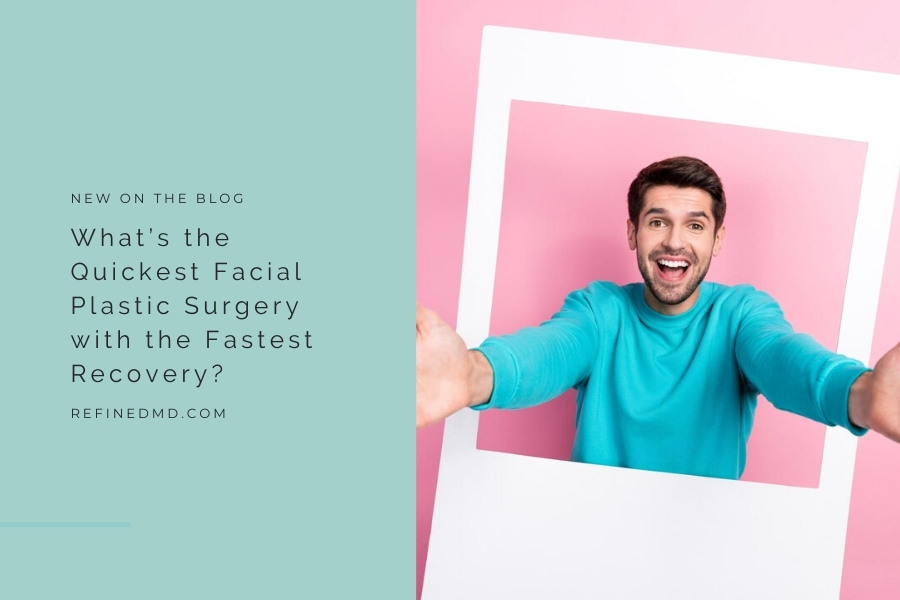
01 Apr What’s the Quickest Facial Plastic Surgery with the Fastest Recovery?
Recovery time can be a big factor when it comes to planning your plastic surgery. At RefinedMD, board-certified Dr. Sudeep Roy is committed to giving patients outstanding results, but that requires collaboration—aftercare is essential to both the healing process and optimal results. Sometimes patients ask what the quickest facial plastic surgery is (since the face is where we tend to show signs of aging first) and many are surprised to find out that it’s blepharoplasty.
Also known as an eyelid lift, blepharoplasty can be performed on the top eyelids, bottom lids, or both (during the same surgery). Typically, blepharoplasty takes less than one hour, which is relatively quick for a cosmetic surgery. The length of a surgery can be a factor when considering plastic surgery, but for many patients the more important detail is how long will recovery take. This is especially true for any facial procedure since, if you want discretion, you may want to lay low until your face looks “normal” again. Typically, most patients feel confident going about their daily social tasks within two weeks of blepharoplasty.
Recovering from Eyelid Lifts
If you opt for an upper eyelid lift, the incisions are placed in the natural crease of the eyelid. This makes them easy to camouflage since you have a line there already. Excess skin is trimmed away and the eyelid is sutured back together. It’s an effective way to correct ptosis (eyelid sagging), whether caused by aging, genetic factors, or trauma such as wearing out the levator muscles. Patients can expect redness, swelling, and bruising around the eyes following this surgery.
Lower blepharoplasty is different, and addresses mainly the bags and wrinkles below the eyelids. If this sagging is caused by loose skin, incisions are made along the lower lashline so that skin can be trimmed away.
However, if bags are the problem and are exclusively caused by pockets of fat, you may not need a traditional blepharoplasty. Instead, fat removal can be performed and in this case the incision is made inside the eyelid so it is never seen. Sometimes a patient may require both fat pocket removal and excess skin removal. If skin is removed, there is a chance that you may temporarily lose the bottom lashes, but don’t worry—they will grow back and this isn’t noticeable to most people. Like an upper bleph, swelling, redness, and bruising are to be expect. You may also have sutures extending from your bottom lashline and taped near your eyebrows. This isn’t painful, but can be annoying and most people don’t want to be seen in public like this. These sutures are removed after just a few days and help the lower lid adjust to its new position.
Why Healing is Quick
The area around the eyes has a lot of vascularity (blood flow). Combine this with the fact that the surgery itself is quick and the incisions are quite small, and that’s a recipe for a fast recovery. Good blood flow is paramount for helping the body to recover—which is why tearing a ligament (which has virtually no blood flow) takes so long to heal. Plus, blepharoplasty surgery can dramatically improve your appearance, helping you look younger, better rested, and healthier with a very short recovery period.
However, keep in mind that just because you’ll be able to see close to your final result in just a couple of weeks, this doesn’t mean that the body is fully recovered. It’s important to carefully follow all aftercare instructions provided by your surgeon for the best recovery and results. For avid gym-goers, this includes not straying from your doctor-recommended return to workout routines. It’s not worth getting in an extra workout at the expense of your cosmetic surgery.
Blepharoplasty is a way to get dramatic results fast. However, you can also combine it with surgeries that require a little more downtime, such as a facelift or mini lift. These surgeries can often all be performed during the same surgical appointment, so you can compound surgery time and downtime. Some people aren’t sure exactly which treatments they require to get the outcome they want—and that’s where a consultation comes into play. To schedule yours with Dr. Roy, call RefinedMD during office hours or complete the online contact form right now.
